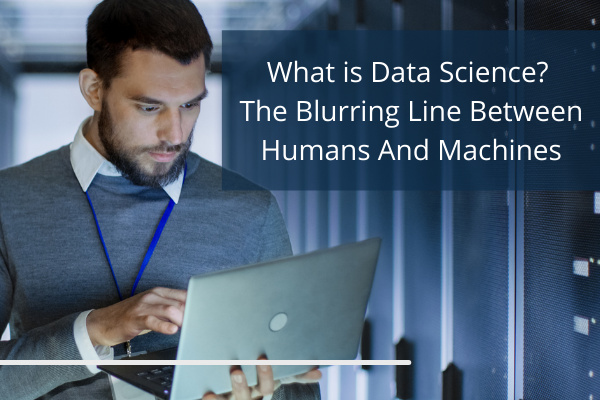Answering the question “What is data science?” requires a thoughtful and complex response, but the simple explanation is this: data science takes the scientific method, algorithms, and other processes and uses these to find insights and knowledge within a data set. It often integrates with artificial intelligence, machine learning, and more.
The field of data science is a constantly changing sector, making it an exciting career choice. In fact, the Harvard Business Review called the data scientist profession the “sexiest” job of the 21st century.
What does a data scientist do?
Data Scientists take big data, find patterns, analyze them, and help to provide crucial information that makes data-driven decisions possible.
Since this is such a quickly-moving field, it is vital to learn from others and share information. Here, TechGenies’ leading minds discuss the answers to commonly asked data science questions.
How close is artificial intelligence to natural intelligence?
Artificial intelligence (AI) uses data to predict what will happen. We encounter AI in our everyday lives in the form of Alexa, Siri, or other virtual assistants.
“The intelligence they [virtual assistants] have is pretty high. The biggest difference between artificial intelligence and natural intelligence comes down to common sense,” said Bharat Sharma, Head of Data Science at TechGenies.
Both AI and Natural Intelligence have their strengths. Natural intelligence has the ability to perceive, understand, and judge everyday occurrences. This is better known as common sense and is something that AI doesn’t have. In other ways, AI is far ahead of what the human brain can do.
For example, AI can easily:
-
- Execute certain tasks
-
- Put data together
-
- Use data to find patterns
These skills will prove incredibly valuable as humans and AI continue to work together, but we will always need natural intelligence to be part of the process. Humans can process the answers to what’s right and wrong, and relate the possible answers to “high level” concepts and ideas.
“The human mind is more about ‘what if?’, ‘what would happen?’, and coming up with scenarios. Meanwhile, the machines are the ones actually doing the work. It will not be until humans are able to give machines this higher level of thinking that we will see a very close similarity between artificial and natural intelligence,” said Ryan Bovermann, CTO at TechGenies.
What is artificial emotional intelligence?
Humans will still lead in making the high concept decisions, but the machines and technology we create are ever-evolving. Jonathan Webster, marketing leader at TechGenies, worked as a counselor before he came into the business sector. In Webster’s years as a counselor, he recalls an experimental AI product demonstrated that could listen, read facial expressions, and respond accordingly.
“Based on the interviewee’s facial expression and speech patterns in their voice, the AI was able to respond with another question based on the emotion and feedback perceived,” Webster said.
Artificial emotional intelligence is one of the more sophisticated forms of technology, yet many people have experienced it before through online chatbots. Today, many websites have a chatbot for customers to ask questions about a company’s product or services. Although the responses are being generated by a robot, the AI still asks questions such as “How are you feeling today?” to imitate the conversation the consumer would have with live customer service.
“You can tell the chatbot is a robot, but at least they’re giving me the illusion that they care about how I’m doing today,” Bovermann said. “We have to teach the AI how to be emotionally equipped in order to keep up with emotional human beings.”
According to Psychology Today, as emotional AI continues to develop, we will likely see it affect some or all parts of our lives. This does raise some privacy concerns. Businesses will have to take big, sweeping steps to ensure that customer data is as secure as possible.
Do you need to be an expert in math to get a job in data science?
Data science is a huge field. There are opportunities where you may not have to use math as much as others, such as a domain expert on a data science team or a programmer. Machine learning, however, relies heavily on algorithms.
“The mathematical functions computed by APIs is something you need to know to be a good data scientist,” Sharma said.
Another area of data science that requires math expertise is research, which is a vital part of the process. Data science teams operate best when made up of diverse roles.
“Projects typically don’t have 20 data scientists. There are typically more supporting roles that a technology project would have such as a project manager, coders, QA people, etc.,” Bovermann said. “Certainly there are data scientists doing their part in this, but a lot of times, we see a need for a lot of those roles that aren’t necessarily data scientists.”
Is data science useful in small businesses where the data size isn’t huge?
In short, any business can benefit from making data-driven decisions. According to business.com, data science definitely benefits small businesses, helping them increase efficiency and conversions, thus helping overall revenue. In a time when the future of many small businesses is being threatened by the COVID-19 pandemic, data science may prove to be invaluable.
“What if we could take out the bottom line of just operational expenses on any company by 10 or 20 percent? That’s not only possible but probable and repeatable. Technology doesn’t sleep, get sick, take vacations, and it can run at scale better than humans. In terms of cost savings alone, I would say implementing data science in small businesses is better than in the enterprise organizations,” Bovermann said.
What is pricing like on data science projects on platforms like AWS or Azure?
Pricing on both AWS and Azure are quite similar since they are direct competitors and provide a lot of the same functionalities. That price changes depending on the project size.
“It all depends on the cloud providers’ pricing, which is published and publicly available. Then you have to estimate how much data and compute power you might need to do with whatever you’re trying to achieve,” Bovermann said.
“For example, let’s say you have to train a model for a terabyte or petabyte of data. Or maybe it’s image data that is very high in volume – again, your pricing will change based on the size of data or the amount of “compute” time against that data. There are different options, and it’s well documented on AWS and Azure pricing sheets that scale up and out.” Sharma said.
In some cases, pricing could be in the tens to hundreds of dollars for a very small project. Costs can get into the thousands of dollars as your “data and compute” increases in terms of scale.
Want to learn more about how your company can implement data science?
TechGenies is here to help. Check out the full Data Science webinar here for more information or download our 11 Steps to Implement Data Science Into Your Innovation Strategy Ebook. Contact us today!


